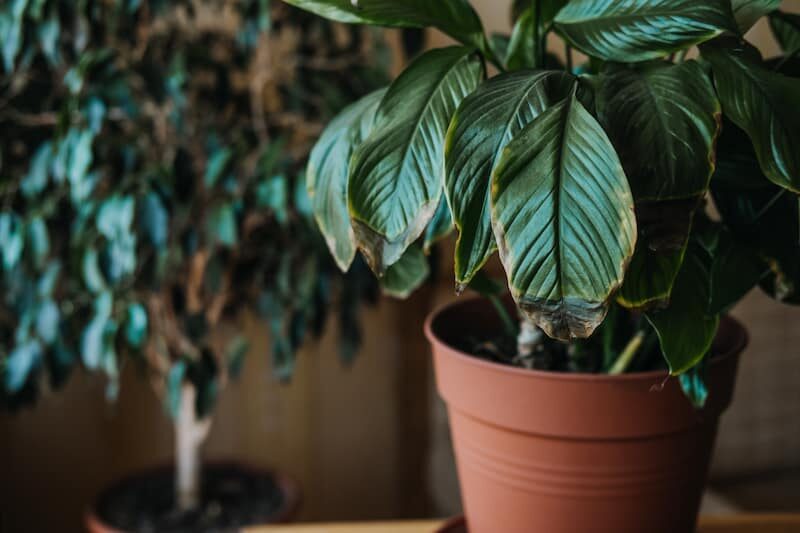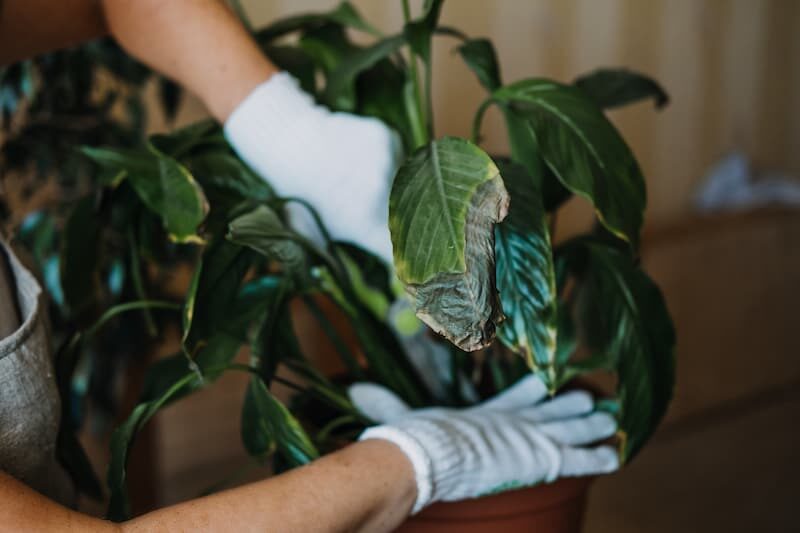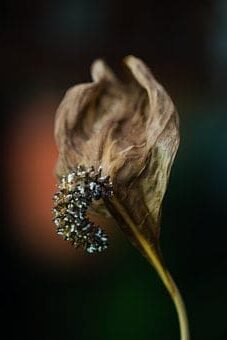Frequent questions that are often heard with regard to the indoor cultivation of Peace Lilies include “Why does my Peace Lily have brown leaf tips? What am I doing wrong?”
For indoor home gardeners, a Spathiphyllum, or Peace Lily, with brown tips is much more common than you might think.
The peace lily plant is a popular houseplant for its ability to adapt to low light environmental conditions, making it perfect for homes and offices. This ability is thanks to the plant’s natural habitat. Peace Lilies grow on the floor of rainforests where light peeks through a canopy of trees and is not bright and direct.
These lovely plants are also appreciated for their elegant white blooms known as spathes amid long dark green foliage. Unfortunately, this naturally elegant houseplant can suffer from brown-tipped leaves and totally brown leaves.
This article will cover why you might see peace lily brown tips, peace lily brown leaves, and peace lily flowers turning brown.
Why Do Peace Lilies Get Brown Leaves and Tips?
There are a variety of reasons why your Peace Lily’s leaf tips are brown. Common reasons include:
- Overwatering
- Underwatering
- Temperature
- Overfertilization
- Lack of humidity
- Plant pests
- Or any combination of the above.
And if you consider the different varieties of this lovely plant, it can become even more complicated.

Peace Lily with Brown Tips – Reasons and Solutions
These are some of the most common brown leaf tips causes and how to fix it.
1. Underwatering or Overwatering the Peace Lily
As with any houseplant, except maybe succulents, determining the correct amount of water can prove to be challenging, and this is particularly so for peace lilies.
Peace lily plants should have moist soil beds, but never be waterlogged or soggy. Be sure there are enough drainage holes in the pot to avoid overwatering and waterlogged soil. Initial signs of brown tips will let you know that you might be overwatering.
Watering thoroughly once or twice weekly should be sufficient. Your peace lily will tell you it needs water with its droopy leaves. The leaves begin to droop slightly as the first signs of underwatering.
If you prefer to wait until foliage droops, it’s possible. Just be sure not to wait too long your plant doesn’t become too dehydrated.
Remove your plant from its basket or decorative container and give it a good shower. Allow excess water to drain thoroughly before replacing it in its pot.
Another water factor to consider is if your water contains chlorine, as this can damage your plant. Most cities will add chlorine to tap water for purification, but it can hurt plants. If you want to use tap water, leave the water to sit out for 24 hours before using it to water the plants. Chlorine will evaporate as it sits out.
2. Environmental Temperature around the Peace Lily
The best temperature for cultivating a peace lily will mirror this plant’s natural habitat. Therefore, a room temperature range between 68° and 85° Fahrenheit is ideal.
The temperature can be cooler in the evening and at nighttime. If your plant be exposed to temperatures below 40°F for an extended period, your peace lily will suffer damage which can include brown leaf tips.
Also, keep your plant away from air conditioning units, vents, and drafts from windows and doors. Those can cause brown leaf tips.
3. Overfeeding or Over Fertilization of the Peace Lily
Overfeeding your peace lily is one of the principal causes of brown-tipped foliage. Peace lilies do not need much in the way of feeding.
If you do wish to fertilize your plant, limit feeding it to four times annually. A standard 20-20-20 fertilizer that is water-soluble and well-diluted is optimal. Most all-purpose indoor plant food will be good for feeding.
4. Lack of Humidity around the Peace Lily
As a tropical plant and rain forest native, your Spathiphyllum likes high humidity. Depending on your local climate, indoor air can be too dry for this plant, so you’ll need to increase humidity levels. When humidity is insufficient in any environment, plant leaf tips will brown.
One quick way to help is using a plant mister. Fill a spray bottle with clean, non-chlorinated water and mist your plant several times weekly.
Another option is to prepare a pebble tray and position your peace lily on top of this tray. Take a tray, fill it with pebbles or pretty stones, and then with water. Set the plant on top but do not allow the container’s drainage holes to come into contact with the water.
As the water begins to evaporate upwards, it will increase the humidity that surrounds your plant. Another option is a humidifier for plants.
5. Pest Infestation of the Peace Lily
Almost all houseplants are at some risk from common pests. The peace lily is susceptible to aphids, mealybugs, and spider mites.
A plant insecticide spray may do the job, including organic insecticides like neem oil. Experts suggest an insecticide containing Resmethrin specifically for mealybugs or aphids.
Peace lilies can be sensitive to chemical components, so insecticide should be used sparingly.

Peace Lily Leaves Turning Brown – Reasons and Solutions
There can be a variety of reasons why a peace lily’s entire leaf turns brown, but the most common is overwatering. Nonetheless, it’s not the only reason. Below are the most common reasons and solutions on how to fix the browned leaves.
Because it may be difficult to identify the problem, you’ll want to look for other signs and symptoms as to what’s happening with your plant.
1. Overwatering the Peace Lily
Overwatering is the main cause of brown leaves, damage, and death. Your peace lily’s soil should be moist, but never waterlogged or soggy.
Pots and containers need enough drainage holes for excess water to drain out. Yellow leaves will be an early indication of overwatering.
Overwatering will also cause root rot. Should this happen, you need to remove the plant from the wet soil and trim any roots that are affected. You can then dip the remaining healthy part of the plant in a 3% hydrogen peroxide solution and place it in fresh soil. Hopefully, this will stop the fungal spread.
2. Underwatering the Peace Lily
On the flip side, underwatering and providing insufficient water will also cause leaves to turn brown and crispy.
If you have been watering normally, check to make sure water is reaching the root system and that the soil is not compacted and well-aerated.
3. Mineral Build-up of the Peace Lily
High levels of mineral build-up can turn your peace lily’s leaves brown. This happens when the water is particularly hard or when you have overfertilized.
Consider flushing out the soil bed with distilled water and letting the extra water drain sufficiently. That will help to flush out high amounts of minerals.
4. Excessive Sunlight Exposure to the Peace Lily
Excessive direct sunlight and sunburn can cause leaves to brown or blacken.
Move your peace lily plant out of direct sunlight. But that doesn’t mean to keep it away from light entirely. Still make sure that it receives plenty of bright, indirect light.
5. Peace Lily Leaves Blackening
Sometimes leaves don’t stop at brown and will turn black. This can be caused by leaf burn from direct sunlight exposure, exposure to cold drafts by a window or doorway, underwatering, and fungal or bacterial infection.
In the case of an infection, it may be caused by overwatering or by a pathogen in the soil that you brought your plant home in. Unhealthy roots and leaves need to be removed. The plant should be replanted in fresh dry soil and a fungicide applied.
Learn more in the in-depth article about Peace Lily Leaves Turning Black.

Peace Lily Flowers Turning Brown – Reasons and Solutions
When it comes to the lovely white peace lily flowers turning brown, remember that no flower lasts forever. The most common cause will be that the flower has come to the end of its life cycle.
Your plant may also be at the end of its flowering season. Peace lily flowers will usually bloom in the spring and perhaps a second time in the fall.
Peace lilies may also drop blooms because they are stressed from watering, temperatures, or any of the same reasons that create problems with foliage.
If you see your bloom turning brown, examine the leaves to see if they also are showing signs of stress. If not, your flower may just be at the end of its cycle.
Flowers may also turn green as opposed to brown. This is normal in a bloom’s life cycle. They begin green, turn white, and often return to green before dying. If your flower blooms green and remains green, it may be receiving too much direct sunlight. Try placing it in partial shade.
If your plant isn’t flowering at all, it may need more indirect light or it’s been overfertilized.
How to Prevent Brown Tips, Leaves, and Flowers
Good care of your peace lily from the start will help prevent your plant from developing brown tips, leaves, or flowers.
Keep these simple care tips in mind when caring for your peace lily:
- Light – The peace lily prefers bright indirect light, but can adapt successfully to lower and medium-light environments. Strong direct sunlight should be avoided to protect foliage from burning.
- Watering – Water your plant once or twice a week. The amount of water should be just enough to keep the soil moist and not wet or soggy. Mist your plant occasionally to increase humidity if your home is dry.
- Pruning – Trim away unattractive, brown or black leaves with clean scissors or a blade. Never remove more than one-third of the plant at the same time. Also, trim away damaged leaf edges to maintain the natural shape of the leaf.
- Keep Your Peace Lily Leaves Clean – Dust your plant’s foliage to help enable photosynthesis. Use a damp cloth to wipe each leaf clean. Support the leaf underneath while cleaning to avoid tears.
Peace Lily Brown Leaves, Tips and Flowers Final Thoughts
The peace lily is a beautiful addition to any garden. It’s easy to grow and looks great indoors or out. With proper care, it’ll last for many years.
Keep in mind the signs of peace lily brown tips, leaves turning brown, and flowers turning brown. Follow the solutions above and you can help revive your peace lilies.
Check out these other articles to learn more about the peace lily:
- Is Peace Lily Plant Toxic to Dogs?
- Is Peace Lily Plant Toxic to Cats?
- Why Do Peace Lily Leaves Turn Yellow?
Peace Lily Brown Leaves, Tips and Flowers FAQs
Should I cut the brown tips off my peace lily?
Yes, you can cut the brown tips off your peace lily. You don’t want to do this though unless you’re sure what caused the brown tips. Cutting them off won’t cure the problem, but it’ll make the plant look better. Be sure to find what the cause was and resolve that issue to prevent future brown tip
What causes brown leaf tips on peace lily?
Brown leaf tips on the peace lily can be caused by several different factors, including:
Too Much Sunlight
Overwatering
Underwatering
Over-fertilization
Extreme Temperatures
Lack of Humidity and Low Moisture Level
Leaf Disease
Poor Air Circulation
Pest Infestations
How do you fix brown tips on peace lily?
Peace lilies are prone to having brown tips on their leaves. To fix brown tips and prevent that from happening, make sure you keep the soil moist during the summer months. Watering 1-2 times a week will be enough. If you notice any brown tips, remove them immediately by cutting off the stem. Be careful when doing this because the roots are very fragile.
How often should I water my peace lily?
Peace Lilies love moist conditions. Water them regularly during the summer months when temperatures reach 80 degrees Fahrenheit. 1-2 times per week should be good, but it’s best to keep an eye on your soil’s moisture. Stick a finger an inch into the top of the soil and if it’s moist, you can delay watering. During the winter months, keep them watered once a week.
How do I get my peace lily to flower again?
Encourage your peace lily to flower by making sure it receives plenty of bright indirect light. The main reasons a peace lily doesn’t flower is due to insufficient light. Peace lilies generally bloom only once per year in the spring and possibly a second time in the fall with the right conditions. Giving it enough light, water, and fertilizer will help entice the peace lily to flower again.

